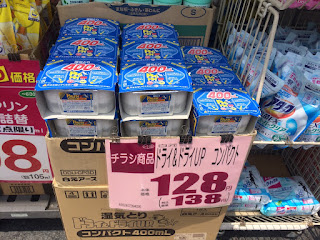Early summer (
shoka =初夏) is a lovely cool season in Japan; today was a perfect 26℃ with a cool breeze blowing and beautiful blue skies. But this is the calm before the storm - literally - since the rainy season, which started in
Okinawa on May 13th, will see a lot of rainy days in Tokyo from early June for four or five weeks.
 |
| Shikke tori packs which soak up moisture on sale now! |
The worst thing though is not so much the rain - it doesn't rain every day by any means - but the humidity. Whereas the Japanese winter is very dry, the Japanese summer, especially the rainy season, is very damp and sticky. The
average humidity level (
shitsudo =湿度) in January in Tokyo is around 50% while the average for July is close to 80%. Consequently, a humidifier (
kashitsuki =加湿器)is great for skin and avoiding sore throats during the winter while a de-humidifier or
joshitsuki (除湿機) is indispensable in the summer (most air conditioners in Japan also have a "dry"
joshitsu function). The former adds (加) moisture (湿) to the air while the latter removes (除) moisture (湿)from the air. Small talk about the weather in summer - which the Japanese love almost as much as the British - will typically include phrases that describe the climate as
jime-jime (damp/clammy) or
mushi-atsui (humid/sultry), the latter combining the
kanji for steam and hot (蒸し暑い).
If you're worried about mouldy futons, damp shoes, and clothes never drying but concerned about your electricity bill, help is at hand: small plastic cartons called
shikke tori (しっけとり=湿気とり) which absorb moisture can be picked up very cheaply at pharmacies (see picture above) and placed in closets and living spaces. An added bonus is that they usually absorb bad smells as well!
